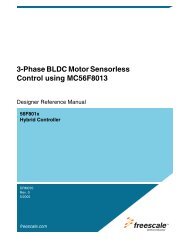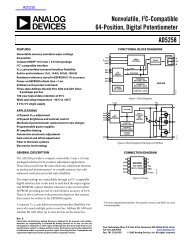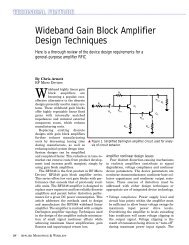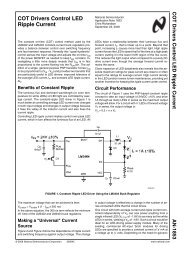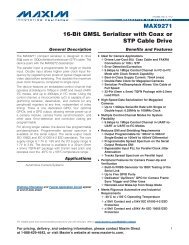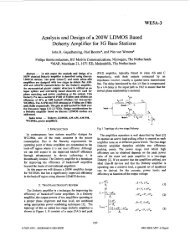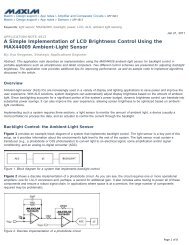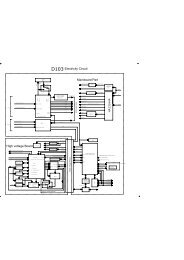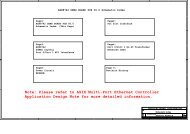A Multi-Carrier UHF Passive RFID System
A Multi-Carrier UHF Passive RFID System
A Multi-Carrier UHF Passive RFID System
You also want an ePaper? Increase the reach of your titles
YUMPU automatically turns print PDFs into web optimized ePapers that Google loves.
A <strong>Multi</strong>-<strong>Carrier</strong> <strong>UHF</strong> <strong>Passive</strong> <strong>RFID</strong> <strong>System</strong><br />
Hsin-Chin Liu, Yung-Ting Chen, and Wen-Shin Tzeng<br />
Department of Electrical Engineering<br />
National Taiwan University of Science and Technology<br />
Taipei, 106, Taiwan<br />
hcliu@mail.ntust.edu.tw<br />
Abstract<br />
The “Gen2” specification for <strong>UHF</strong> passive <strong>RFID</strong><br />
system released by EPCglobal has become an intense<br />
research interest. A Gen2 tag derives its power from<br />
the RF wave emitted by a Gen2 <strong>RFID</strong> reader and<br />
responds its modulated backscatter signals to the<br />
reader. Due to the large propagation loss, the<br />
accessible range of a Gen2 tag is hence limited.<br />
Moreover, the readability of a Gen2 tag is often<br />
influenced by the multipath fading problem. In this<br />
paper we propose a multi-carrier <strong>UHF</strong> passive <strong>RFID</strong><br />
system that can effectively extend the accessible range<br />
of a Gen2 tag. In addition, we investigate the multiband<br />
backscatter property of Gen2 tags, which can be<br />
utilized to mitigate the multipath fading problems.<br />
1. Introduction<br />
The Radio frequency identification (<strong>RFID</strong>)<br />
technology with its prosperous market and its diverse<br />
applications has gained much attention recently. Owing<br />
to the low cost, small size, long accessible range tags,<br />
the <strong>UHF</strong> passive <strong>RFID</strong> system is especially promoted<br />
by EPCglobal. In 2005, The “Gen2” specification for<br />
<strong>UHF</strong> passive <strong>RFID</strong> system is released by EPCglobal<br />
[1]. Because a Gen2 tag derives its power from the RF<br />
waves emitted by a Gen2 <strong>RFID</strong> reader and responds its<br />
modulated backscatter (MBS) signals to the reader, the<br />
accessible range is hence limited due to the large<br />
propagation loss. Besides the free space attenuation,<br />
the multipath fading effect can often result in<br />
readability problems.<br />
In an ordinary EPCglobal Gen2 <strong>RFID</strong> system [1], an<br />
integrated reader not only transmits continuous waves<br />
(CW) to provide energy and the backscatter carrier to<br />
tags, but also sends the pulse-interval encoding (PIE)<br />
reader-to-tag (R-T) commands to tags and receives the<br />
tag-to-reader (T-R) responses. Assuming that the<br />
maximum accessible distance between a reader and a<br />
tag is d<br />
0<br />
, and the power of the CW emitted from the<br />
reader is P cw<br />
as shown in Figure 1(a). In accordance<br />
with the Friis equation [3], the received power of the<br />
P can be presented as Eq.(1).<br />
tag<br />
tag<br />
⎛ λ ⎞<br />
P = P G G<br />
tag cw ⎜ ⎟ , (1)<br />
⎝4π<br />
d<br />
reader tag<br />
0 ⎠<br />
where λ is the wavelength of the CW, G reader<br />
and<br />
G<br />
tag<br />
are the power gains of the reader and tag<br />
antennas respectively.<br />
When the tag is powered up, it listens for the R-T<br />
commands and adjusts its impedance match between<br />
the IC and antenna appropriately to respond the MBS<br />
T-R signals. The power of the MBS signal received at<br />
the reader Prx<br />
can be written as Eq.(2)<br />
2<br />
⎛ λ ⎞<br />
Prx = Ptag ⎜ ⎟ GreaderG<br />
. (2)<br />
tag<br />
⎝4π<br />
d0<br />
⎠<br />
Substituting P from Eq.(1) into Eq.(2), we see<br />
tag<br />
that P<br />
rx<br />
is reverse proportional to the four squares of<br />
d<br />
0<br />
.<br />
The accessible distance of a Gen2 tag is mainly<br />
determined by two factors: the power of the MBS<br />
received at the reader P rx<br />
and the received power of<br />
the tag P tag<br />
. For the former factor, a high sensitivity<br />
reader can solve the weak P rx<br />
problem. However, the<br />
latter one is more troublesome. An intuitive solution of<br />
increasing the P tag<br />
without tag modification is to<br />
enlarge the P cw<br />
. However it is impractical due to<br />
healthy concerns, the industrial, scientific and medical<br />
(ISM) band compliance issues, and the restriction of<br />
the local regulations.<br />
In order to overcome the insufficient P tag<br />
problem,<br />
we propose a multi-carrier <strong>UHF</strong> passive <strong>RFID</strong> system,<br />
2<br />
Proceedings of the 2007 International Symposium<br />
on Applications and the Internet Workshops (SAINTW'07)<br />
0-7695-2757-4/07 $20.00 © 2007
whose diagrammatic sketch is shown in Figure 1(b).<br />
The proposed system not only can provide sufficient<br />
energy to Gen2 tags but also can extend its accessible<br />
range. Furthermore, taking the advantages of multiple<br />
carriers, the reader can be benefited from the frequency<br />
diversity gain and the multipath fading problem can be<br />
mitigated.<br />
The remainder of this paper is organized as follows:<br />
Section 2 introduces the proposed system. Section 3<br />
presents the experimental results. Section 4 draws<br />
conclusions.<br />
2. The <strong>Multi</strong>-carrier <strong>UHF</strong> passive <strong>RFID</strong><br />
system<br />
Unlike the integrated reader in an ordinary <strong>UHF</strong><br />
passive <strong>RFID</strong> system, the reader in a multi-carrier <strong>UHF</strong><br />
passive <strong>RFID</strong> system is decomposed into two parts: a<br />
CW emitter (CWE) and a transceiver. The CWE can be<br />
preset leaky cables or radio source(s) close to tags,<br />
which emit a CW with frequency f<br />
c<br />
to illuminate tags.<br />
The CWE constantly provides energy and the MBS<br />
carrier(s) to the tags. The transceiver, which can be<br />
farther away from the tags, is mainly used to transmit<br />
the R-T commands and receive the T-R responses.<br />
As illustrated in Figure 1(b), the received power of<br />
the tag<br />
P<br />
'<br />
tag<br />
can be presented as Eq.(3).<br />
2<br />
' ' ⎛ λ ⎞<br />
c<br />
tag<br />
=<br />
cw ⎜ ⎟ cwe tag<br />
4π<br />
d1<br />
P P G G , (3)<br />
⎝ ⎠<br />
where P denotes the power of the CW emitted from<br />
'<br />
cw<br />
the CWE,<br />
λ<br />
c<br />
is the wavelength of the CW, and d 1<br />
is<br />
the distance between the CWE and the tag.<br />
G cwe<br />
and<br />
G<br />
tag<br />
are the power gains of the CWE and tag antennas<br />
respectively. In addition, the power of the MBS<br />
received at the reader<br />
P can be written as Eq.(4).<br />
'<br />
rx<br />
2<br />
' '<br />
⎛ λ ⎞<br />
rx<br />
=<br />
tag ⎜ ⎟ rx tag<br />
4π<br />
d2<br />
P P G G , (4)<br />
⎝ ⎠<br />
where G is the power gains of the transceiver, and<br />
rx<br />
d<br />
2<br />
is the maximum accessible distance between the<br />
transceiver and the tag. Assuming that the antenna<br />
gains of the CWE and the transceiver are the same as<br />
that of the integrated reader in an ordinary system<br />
( Gcwe = Grx = Greader<br />
), and the CW frequencies and<br />
powers in both systems are the same<br />
'<br />
( λ = λc,<br />
Pcw = Pcw), the power of received MBS in<br />
both system can be written as Eq.(5).<br />
' 4<br />
Prx<br />
d0<br />
= . (5)<br />
2 2<br />
Prx<br />
d1d2<br />
'<br />
When d1 < d0<br />
and Prx<br />
= Prx<br />
, d2 > d0<br />
can be<br />
derived. In other words, given the same receiver<br />
sensitivity and the same CW emission power, the<br />
proposed system can effectively extend the accessible<br />
distance between a tag and the receiver. Moreover,<br />
because the tags are plentifully illuminated by the<br />
CWE, the problem of insufficient tag operation energy<br />
is avoided.<br />
A simplified normal operation flow of the proposed<br />
system is illustrated in Figure 2. Before issuing an R-T<br />
command, the transceiver turns on the CWE to emit the<br />
CW, so that the tags nearby the CWE are powered up<br />
and ready for the R-T command. When the accessing<br />
operation is finished, the transceiver turns off the<br />
CWE, and the operation is then terminated.<br />
The proposed system may seem similar with an<br />
ordinary Gen2 system, except the additional CWE. As<br />
a matter of fact, they are substantially different. We<br />
discuss three major differences as below:<br />
2.1. The frequency difference between the<br />
transceiver and the CWE<br />
Because the transceiver and the CWE are<br />
separated in our proposed system, the carrier frequency<br />
of the transceiver ( f<br />
t<br />
) and the frequency of CW ( f<br />
c<br />
)<br />
emitted by the CWE can be different. Assuming the<br />
noise is negligible, the RF signal received by a tag can<br />
be expressed as Eq.(6).<br />
s t = m t cos 2π f t + Acos 2π f t+ φ t , (6)<br />
() () ( t ) ( c ())<br />
where<br />
⎧A , when high level is sent<br />
m()<br />
t =<br />
t<br />
⎨ denotes the<br />
⎩ 0, when low level is sent<br />
waveform of an R-T command from the transceiver,<br />
A denotes the amplitude of the RF signal transmitted<br />
t<br />
by the transceiver, A denotes the amplitude of the CW<br />
emitted by the CWE, and φ () t is the phase different<br />
between the two carriers. Let ∆ f = fc − ft<br />
. After<br />
some manipulations, Eq.(6) can be rewritten as Eq.(7).<br />
s( t) = ⎡<br />
⎣m( t) + Acos( 2π∆ ft+<br />
φ( t)<br />
) ⎤<br />
⎦cos( 2π<br />
ftt)<br />
.(7)<br />
+ Asin 2π∆ ft+<br />
φ t sin 2π<br />
f t<br />
( ()) ( t )<br />
The signal s()<br />
t is firstly passed through the<br />
envelope detection circuit inside the tag IC as shown in<br />
Proceedings of the 2007 International Symposium<br />
on Applications and the Internet Workshops (SAINTW'07)<br />
0-7695-2757-4/07 $20.00 © 2007
Figure 3 [2]. Let s () t denote the output of the circuit<br />
as presented in Eq.(8).<br />
e<br />
e<br />
2 2<br />
() = () + + 2 () cos( 2π∆ + φ()<br />
)<br />
s t m t A Am t ft t<br />
.(8)<br />
Utilizing the Taylor series, se<br />
() t can be expanded as<br />
Eq.(9).<br />
2 2 1<br />
⎡2Am () t cos( 2π∆ ft + φ()<br />
t ) ⎤<br />
Se<br />
() t = A + m () t i{1 + ⎢<br />
⎥<br />
2 ⎢<br />
2 2<br />
⎣<br />
A + m () t ⎥<br />
⎦<br />
2<br />
1<br />
⎡2Am() t cos ( 2π∆ ft + φ()<br />
t ) ⎤<br />
− ⎢<br />
⎥ + remainders}<br />
8<br />
2 2<br />
⎢<br />
⎣<br />
A + m () t ⎥<br />
⎦<br />
.(9)<br />
se<br />
() t is then passed through the LPF as depicted in<br />
Figure 3. Assuming ∆f<br />
is sufficiently large; the high<br />
frequency terms are filtered by the LPF. The<br />
output se<br />
() t can be approximated as Eq.(10).<br />
2 2 1<br />
se<br />
() t = A + m () t −<br />
. (10)<br />
2 2<br />
4 A + m () t<br />
As shown in experimental results, the R-T<br />
command can be correctly recognized by Gen2 tags<br />
under such a circumstance. Contradictorily, when ∆ f<br />
is small, the R-T command is distorted by the CW<br />
emitted by the CWE, and Gen2 tags do not respond the<br />
command.<br />
2.2. The modulation depth of R-T commands<br />
In [1], the modulation depth (MD) of a valid R-T<br />
command is specified to be greater than 80% and less<br />
than 100% in terms of the incident electric field<br />
strength at the tags. The MD is defined as Eq.(11).<br />
EA<br />
− EB<br />
MD = , (11)<br />
EA<br />
where E<br />
A<br />
and E<br />
B<br />
denote the maximum and<br />
minimum amplitudes of the RF envelope in an R-T<br />
command respectively. Figure 4(a) and Figure 4(b)<br />
illustrate an R-T command in an ordinary Gen2 system<br />
and in the proposed system respectively. From Eq.(10)<br />
and Eq.(11), the MD in our proposed system can be<br />
2 2 2 2<br />
A + A − A / A + A .For the<br />
presented as ( t )<br />
typical MD=90%, the power relation between the CWE<br />
and the transceiver can be derived as Eq.(12).<br />
t<br />
P / d + P / d − P / d<br />
' ' '<br />
cw 1 tx 2 cw 1<br />
'<br />
'<br />
Pcw<br />
/ d1+<br />
Ptx<br />
/ d2<br />
= 90% , (12)<br />
'<br />
where P<br />
tx<br />
denotes the maximum transmission power<br />
of the transceiver while sending an R-T command.<br />
2.3. The detection symbol in R-T Commands<br />
In order to decode an R-T command, the tag IC must<br />
have a PIE decoder, which is an edge detector [2]. A<br />
regular Gen2 R-T command cannot be directly used in<br />
the proposed system, because the first falling edge and<br />
the last rising edge of the R-T command, as depicted in<br />
Figure 4(a), cannot be detected by tags. In order to be<br />
compliant with Gen2 tags, two short detection symbols<br />
are added to the head and the tail of each R-T<br />
command in the proposed system as illustrated in<br />
Figure 4(b).<br />
3. Experimental results<br />
An Agilent 89601 vector signal analyzer<br />
incorporating with an Agilent E4445A spectrum<br />
analyzer is used to capture the communication signals<br />
between the transceiver and a Gen2 tag. The<br />
frequencies of the CWE and the transceiver are<br />
915MHz and 917MHz respectively. The R-T Tari is<br />
25us, and the duration of the both detection symbols<br />
are 11us. The powers of the CWE and the transceiver<br />
are adequately adjusted, so that the MD requirement is<br />
satisfied. The snapshots are taken nearby the tags.<br />
Figure 5 shows that the tag MBS is relatively strong.<br />
Under such a circumstance, the accessible range of the<br />
tag can be extended to 4 times longer than that of an<br />
ordinary Gen2 system with the same emission power.<br />
Figure 6 demonstrates an interesting multi-band<br />
backscatter property of Gen2 tags. We let the<br />
transceiver not only send the R-T commands but also<br />
send a low power CW during the tag responses. We<br />
found that the tag MBS presents not only in the carrier<br />
frequencies of CWE but also in the carrier frequencies<br />
of the transceiver (917MHz) as illustrated in Figure 6.<br />
This phenomenon implies that we can apply the<br />
frequency diversity technology (using a multi-carrier<br />
CWE, for instance) to enhance the quality of the tag<br />
MBS and to mitigate the multipath fading problem.<br />
4. Conclusion<br />
In this paper, we proposed a multi-carrier <strong>UHF</strong><br />
passive <strong>RFID</strong> <strong>System</strong>, which can effectively extend the<br />
accessible range of Gen2 tags. Moreover, the multiband<br />
backscatter property of Gen2 tags, which is<br />
Proceedings of the 2007 International Symposium<br />
on Applications and the Internet Workshops (SAINTW'07)<br />
0-7695-2757-4/07 $20.00 © 2007
explored in this paper, can be utilized in future <strong>RFID</strong><br />
system design.<br />
Acknoledgement<br />
Amplitude<br />
First falling<br />
edge<br />
Last rising<br />
edge<br />
E A<br />
This study is partially supported by the National<br />
Science Council of Taiwan under grant no.NSC94-<br />
2218-E-011-011 and Yuen Foong Yu Paper MFG. CO.<br />
References<br />
[1] EPC TM Radio-Frequency Identity Protocols Class-1<br />
Generation-2 <strong>UHF</strong> <strong>RFID</strong> Protocol for Communications at<br />
860MHz-960MHz Version 1.09,<br />
http://www.epcglobalinc.org, 2005.<br />
[2] Zheng Zhu, “<strong>RFID</strong> Analog Front End Design Tutorial,”<br />
http://autoidlabs.eleceng.adelaide.edu.au/Tutorial/<strong>RFID</strong>a<br />
nadesign.pdf, 2004.<br />
[3] A Paulraj, R. Nabar, and D. Core, Introduction to Space-<br />
Time Wireless Communications, Cambridge University<br />
Press, 2003.<br />
(a)<br />
(b)<br />
TAG TAG<br />
P<br />
tag<br />
P<br />
'<br />
tag<br />
d 1<br />
d 0<br />
d 2<br />
'<br />
P cw<br />
CWE<br />
P rx<br />
P cw<br />
Reader<br />
'<br />
P rx<br />
Transceiver<br />
'<br />
P tx<br />
Figure 1. (a) An ordinary <strong>UHF</strong> passive <strong>RFID</strong><br />
system. (b)The multi-carrier <strong>UHF</strong> passive <strong>RFID</strong><br />
system.<br />
Amplitude<br />
E A<br />
(a)<br />
Head Detection<br />
Symbol<br />
E B<br />
E B<br />
(b)<br />
Figure 4. (a) The amplitudes of the RF envelope<br />
in an R-T command in an ordinary Gen2 system.<br />
(b) The amplitudes of the RF envelope in an R-T<br />
command in the proposed system.<br />
t<br />
Tail Detection<br />
Symbol<br />
t<br />
CWE<br />
on<br />
CW<br />
off<br />
Transceiver<br />
Turn on<br />
Query<br />
…<br />
Turn off<br />
Gen2 tags<br />
Figure 2. A simplified operation flow for the multicarrier<br />
<strong>UHF</strong> passive <strong>RFID</strong> system.<br />
t<br />
Figure 5. A snapshot of the R-T and T-R<br />
communications around 915 MHz, which is the<br />
frequency of the CW emitted by the CWE.<br />
Antenna<br />
Rectifier<br />
LPF<br />
Hysteresis<br />
Comapator<br />
Envelope<br />
Detector<br />
Figure 3. The RF envelope detection and low pass<br />
filter inside an <strong>UHF</strong> passive tag [2].<br />
Figure 6. A snapshot of the R-T and T-R<br />
communications around 917 MHz, which is the<br />
carrier frequency of the transceiver.<br />
Proceedings of the 2007 International Symposium<br />
on Applications and the Internet Workshops (SAINTW'07)<br />
0-7695-2757-4/07 $20.00 © 2007



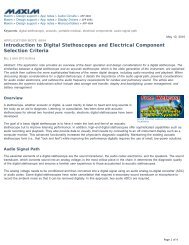
![P-CAD EDA - [Sheet1]](https://img.yumpu.com/49470492/1/190x115/p-cad-eda-sheet1.jpg?quality=85)
